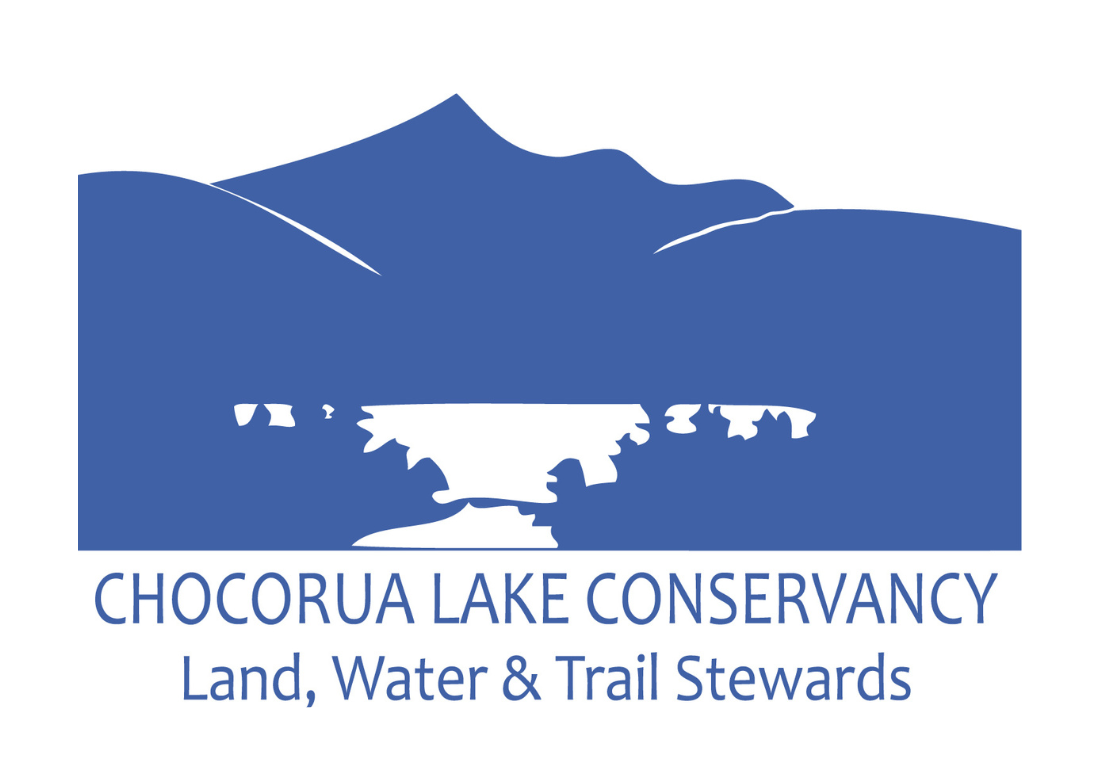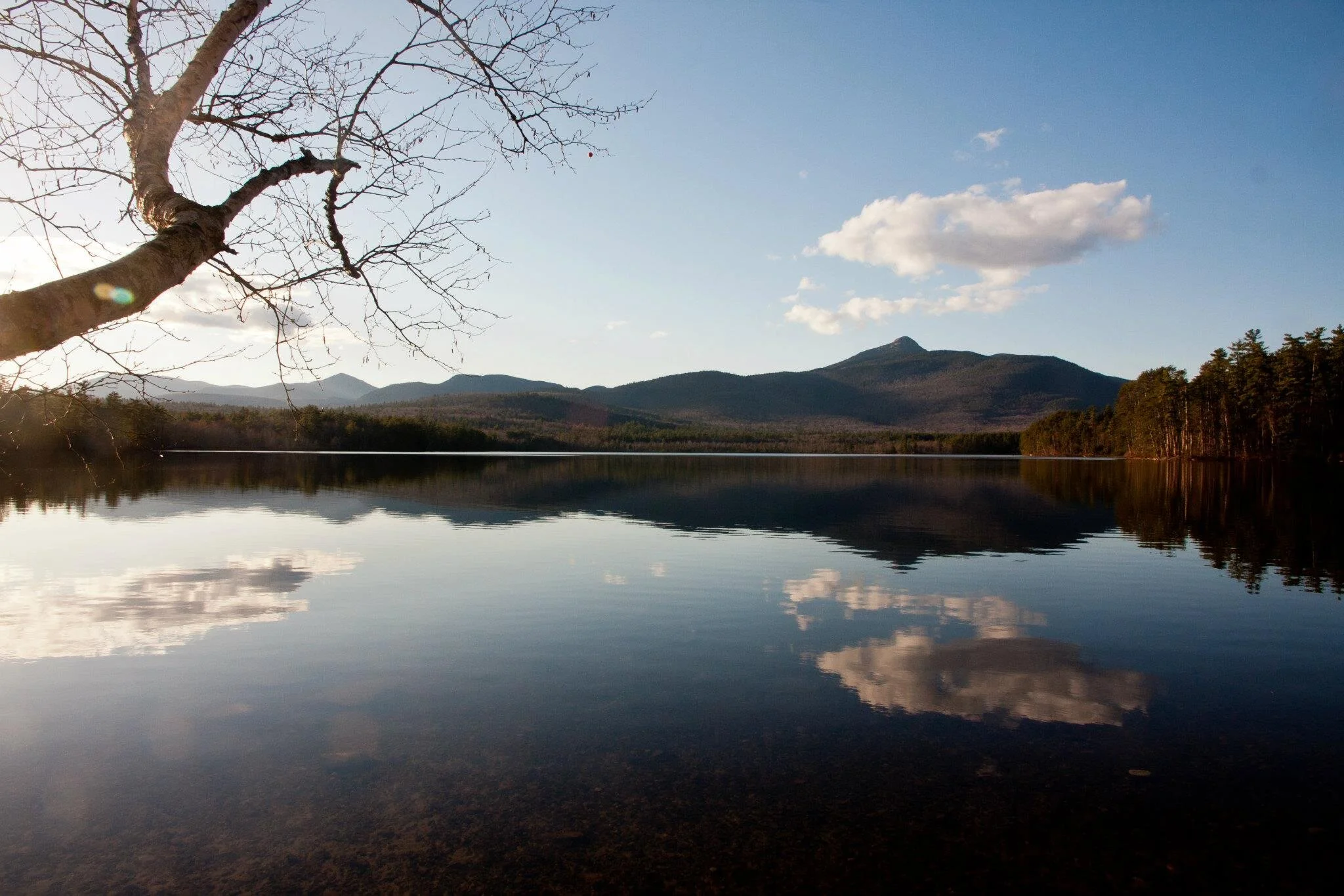A lake is usually classified by scientists as being in one of three possible classes: oligotrophic, mesotrophic or eutrophic.
Water Quality Testing at Chocorua Lake
Merger Implementation & Other Conservancy Activities
Wildlife Sightings From This Past Winter
Three eagles, two mature and one immature, stationed themselves at the head of the Lake eating any leftovers the ice fisherman threw on the ice, as well as a deer carcass. We’ll see if they stay around for their breeding and nesting season. The presence of these carnivorous predators would certainly be upsetting to our beloved loons.
It was a tough winter for humans and wildlife alike! How do animals adapt to the deep snow and cold? Evidence of the deer “yarding up” under hemlocks to avoid the deep snow was abundant, usually on south facing hillsides. This technique of holding steady can go on for days until better conditions prevail. Rough grouse use a similar technique to bed down in powder snow for the duration of a storm, perhaps for several days, and only when disturbed by another critter do they erupt from the depths of the powder, severely startling the trespasser. Their frozen pellets are left under the snow as evidence.
Opossum at the feeder. Photo: Dave Farley
A hungry opossum appeared late in February at Dave Farley’s feeder. This solitary and nomadic critter is more suited to the warmer regions of the southern United States, with a strong immunity to snake venom and a coat of awn hair only, like all marsupials. He is not well outfitted for the winter we had this year, and his feet and his tail can become badly frostbitten, causing a lot of pain.
Otters can navigate easily across the snow by sliding on their bellies, and their telltale track-‐slides have been spotted coming from the Smith’s drive, down to Walley Brook, on to the brook behind the Hallowell house, on to the pond near the Helm’s drive, and continuing along the shore to the north end of the lake!
The resident porcupine continues to travel between its den under the Smith’s front steps to the Hofheinz woodpile; in both places, he leaves his droppings neatly piled outside.
A downy woodpecker and a tufted titmouse at the feeder. Photo: Harriet Hofheinz
Bird feeders are a godsend to our feathered friends in the winter, and some birds don’t survive without them. But the hardy do, as they have for a long time before we were around. John Watkins has seen pileated, hairy, downy and red bellied woodpeckers, as well as the usual nuthatches, chickadees, purple finches, blue jays etc. In addition, more northern species such as the redpoll, crossbill, and tree sparrow are coming to his feeder. Barred owls on Groundhog Day began their mating rituals with lots of characteristic calls to one another. They seemed unfazed by the weather.
Like clockwork, our resident loons happily returned soon after the ice was out to investigate and prepare their nest. With no identifying leg bands, it’s impossible to be sure, but it is presumed that this is the same pair of loons from last year.
Speaking of loons, John Conroy reported that the Loon Center rescued three 1st-year loons from the frozen coast in January and February. Two did not survive, but the one found in the parking lot, was released after it recuperated at the Center.
Banner: Ed Parsons
Loons on Chocorua Lake: 2014 Report
By John Cooley, Biologist, Loon Preservation Committee
Chocorua Lake’s two nesting loons were again successful in 2014, hatching two chicks that survived. This past year continues a long string of successful years of loon reproductive success on the lake. With the exception of 2011, loons have bred successfully on Chocorua Lake in all of the last 15 years, hatching 23 chicks in that time, with 20 surviving.
Loons in Chororua Lake have enjoyed twice the statewide average for reproductive success over the past 15 years, establishing Chocorua Lake as one of a small set of lakes in the state that are core habitat for the loon in New Hampshire, which play a disproportionately large role in the long-term viability of the loon population in the state.
Chocorua Lake is prime loon nesting habitat, but sat vacant – as far as nesting goes—for a quarter century. Although adult loons had been noted on Chocorua Lake since monitoring began in the mid-1970s, almost a decade passed in the 1990s with only intermittent loon presence. Successful nesting on Chocorua Lake wasn’t documented until the year 2000.
The long wait for loons to become an established, successful presence at Chocorua Lake reflects the trajectory of the population as a whole in New Hampshire. From a low point in 1975 with about 100 pairs, this threatened species has slowly reoccupied its historical distribution in the state. New Hampshire now has about 280 pairs of loons across 133 lakes. Loons disperse and colonize a few miles at a time, so the pace of recovery is gradual. But once established, a fit pair of individual loons can live and breed on the same lake for decades, turning it into a powerhouse.
Loons, which are threatened in New Hampshire and protected federally, were hard hit by contaminants and human interaction in the 1970s. The black-and-white birds with the haunting call are still not as plentiful as they once were in New Hampshire. One of the biggest culprits is lead fishing tackle, which accounts for almost half of adult loon deaths every year. A new state law that takes effect in 2016 bans lead sinkers smaller than 1 ounce; the birds are able to ingest the smaller jigs, which can kill them in two to four weeks.
The loons on Chocorua Lake had excellent help this summer from the first annual Save the Loons Fishing Tournament, organized by 13-year old Ryan Buchanan and his family and friends. The contest attracted an enthusiastic crew of anglers to the Grove. The Narrows Bridge next to the Grove is a popular fishing spot, and this was a perfect place to promote safe angling. Providing loon-friendly non-lead tackle and information on loons, the event was a wonderful success. Proceeds benefited the Loon Preservation Committee.
The fishing tournament is a great counterpoint to 2006, when LPC staff collected a dead adult male loon at the Narrows Bridge that had been poisoned by a lead fishing sinker. Such efforts are exactly what is needed to turn the tide and prevent lead poisoning in loons and other wildlife, which is currently the biggest impediment to the continued recovery of loons throughout the state. A huge thanks to Ryan and family for leading the way!
The Loon Protection Committee wishes to acknowledge the generous help of Chocorua community member Rachel Page in finding a home with us for the truly valuable resource of some of the extensive scientific journal collection of the late Malcolm Coulter. As a local but renowned ornithologist, LPC staff knew Malcolm and admired his work, and are grateful to benefit from (and glad to share with interested borrowers) the journal titles that Rachel has provided to LPC. Many thanks, and good memories of Malcolm.
LPC is also extremely grateful for the help of Chocorua Lake resident Alice Waylett and other loon watchers who have kept a close eye on loon activity on the lake over the years and are often our first notice of the spring return, the beginning of nesting, and other important events in the loon season.
Things You Can Do Help Protect Loons
View loons from a respectful distance of at least 200 feet. Do not approach nests, individual adults, or loon chicks.
Don't fish next to a loon. Loons can mistake lures and jigs for their live prey items. Every year loons die from swallowing lures and entanglement in fishing line.
Use non-lead fishing tackle. Loons, eagles, swans, and other waterbirds die from ingesting lead fishing tackle. They ingest the tackle when they eat fish that have tackle left inside by anglers or when they pick up pebbles (or in this case, sinkers or jig heads that look like pebbles) to aid with digestion. Small sinkers and jigs seem to be the biggest problem, and only one lead sinker will kill a loon from lead poisoning.
Spread the word about these issues to your family, guests, neighbors, and other visitors to the lake.
More About Lead Sinkers
Lead fishing tackle was responsible for 49% of documented New Hampshire adult loon mortalities from 1989-2011. In 2000, legislation took effect in New Hampshire to restrict the use in lakes and ponds of lead sinkers weighing one ounce or less, and lead-headed jigs measuring less than one inch in length (including the hook).
Subsequent legislation to restrict the use of these tackle in all freshwater in New Hampshire took effect in 2005, and the sale of these tackle was restricted beginning in 2006. Analysis comparing pre- and post-restriction periods (1989-1999 vs. 2000-2011) found that the rate of lead fishing tackle mortalities in New Hampshire loons fell subsequent to these restrictions; however, this reduction has not been large enough to protect New Hampshire's loon population, and recently (2006-2011) rates of lead tackle mortalities have begun to rise once again.









